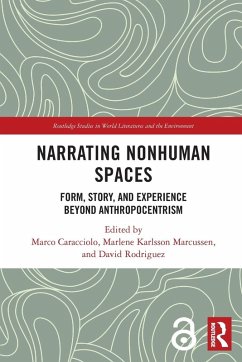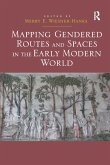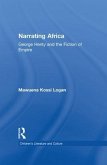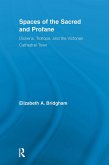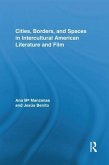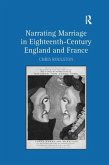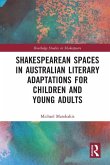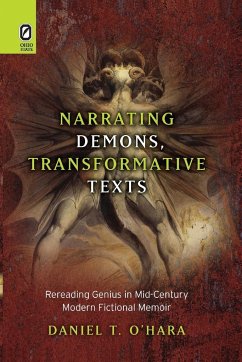Narrating Nonhuman Spaces
Form, Story, and Experience Beyond Anthropocentrism
Herausgeber: Caracciolo, Marco; Rodriguez, David; Marcussen, Marlene Karlsson
Narrating Nonhuman Spaces
Form, Story, and Experience Beyond Anthropocentrism
Herausgeber: Caracciolo, Marco; Rodriguez, David; Marcussen, Marlene Karlsson
- Broschiertes Buch
- Merkliste
- Auf die Merkliste
- Bewerten Bewerten
- Teilen
- Produkt teilen
- Produkterinnerung
- Produkterinnerung
This collection builds on the assumption that our understanding of the nonhuman world is bound up with the experience of space: thinking about and with nonhuman spaces destabilizes human-scale assumptions.
Andere Kunden interessierten sich auch für
![Mapping Gendered Routes and Spaces in the Early Modern World Mapping Gendered Routes and Spaces in the Early Modern World]() Mapping Gendered Routes and Spaces in the Early Modern World66,99 €
Mapping Gendered Routes and Spaces in the Early Modern World66,99 €![Narrating Africa Narrating Africa]() Mawuena Kossi LoganNarrating Africa74,99 €
Mawuena Kossi LoganNarrating Africa74,99 €![Spaces of the Sacred and Profane Spaces of the Sacred and Profane]() Elizabeth A. BridghamSpaces of the Sacred and Profane74,99 €
Elizabeth A. BridghamSpaces of the Sacred and Profane74,99 €![Cities, Borders and Spaces in Intercultural American Literature and Film Cities, Borders and Spaces in Intercultural American Literature and Film]() Ana M. ManzanasCities, Borders and Spaces in Intercultural American Literature and Film72,99 €
Ana M. ManzanasCities, Borders and Spaces in Intercultural American Literature and Film72,99 €![Narrating Marriage in Eighteenth-Century England and France Narrating Marriage in Eighteenth-Century England and France]() Chris RoulstonNarrating Marriage in Eighteenth-Century England and France95,99 €
Chris RoulstonNarrating Marriage in Eighteenth-Century England and France95,99 €![Shakespearean Spaces in Australian Literary Adaptations for Children and Young Adults Shakespearean Spaces in Australian Literary Adaptations for Children and Young Adults]() Michael MarokakisShakespearean Spaces in Australian Literary Adaptations for Children and Young Adults65,99 €
Michael MarokakisShakespearean Spaces in Australian Literary Adaptations for Children and Young Adults65,99 €![Narrating Demons, Transformative Texts Narrating Demons, Transformative Texts]() Daniel T. O'HaraNarrating Demons, Transformative Texts23,99 €
Daniel T. O'HaraNarrating Demons, Transformative Texts23,99 €-
-
-
This collection builds on the assumption that our understanding of the nonhuman world is bound up with the experience of space: thinking about and with nonhuman spaces destabilizes human-scale assumptions.
Hinweis: Dieser Artikel kann nur an eine deutsche Lieferadresse ausgeliefert werden.
Hinweis: Dieser Artikel kann nur an eine deutsche Lieferadresse ausgeliefert werden.
Produktdetails
- Produktdetails
- Verlag: Routledge
- Seitenzahl: 252
- Erscheinungstermin: 31. Mai 2023
- Englisch
- Abmessung: 229mm x 152mm x 14mm
- Gewicht: 371g
- ISBN-13: 9781032021041
- ISBN-10: 1032021047
- Artikelnr.: 67824781
- Herstellerkennzeichnung
- Libri GmbH
- Europaallee 1
- 36244 Bad Hersfeld
- gpsr@libri.de
- Verlag: Routledge
- Seitenzahl: 252
- Erscheinungstermin: 31. Mai 2023
- Englisch
- Abmessung: 229mm x 152mm x 14mm
- Gewicht: 371g
- ISBN-13: 9781032021041
- ISBN-10: 1032021047
- Artikelnr.: 67824781
- Herstellerkennzeichnung
- Libri GmbH
- Europaallee 1
- 36244 Bad Hersfeld
- gpsr@libri.de
Marco Caracciolo is Associate Professor of English and Literary Theory at Ghent University in Belgium, where he leads the ERC Starting Grant project "Narrating the Mesh." Marco's work explores the phenomenology of narrative, or the structure of the experiences afforded by literary fiction and other narrative media. He is the author of five books, including most recently Narrating the Mesh: Form and Story in the Anthropocene (2021). Marlene Karlsson Marcussen holds a PhD in comparative literature from the University of Southern Denmark, where she currently is a scientific assistant. She is the co-editor of How Literature Comes to Matter: Post-Anthropocentric Approaches to Fiction (2021) and has published a number of publications on modernism, materiality, and space such as "The Postapocalyptic Motherhood" (2019) and "The Abundance of Things in the Midst of Writing: A Post-Anthropocentric View on Description and Georges Perec's 'Still Life/Style Leaf'" (2021). David Rodriguez is a postdoctoral researcher. He holds a PhD in English from Stony Brook University. His dissertation, Spaces of Indeterminacy: Aerial Description and Environmental Imagination in 20th Century American Fiction, studies images of the environment in the novels of Willa Cather, Paul Bowles, and Don DeLillo. He has written further about the phenomenology of reading descriptions of the view from above in Frontiers of Narrative Studies and econarratology in English Studies.
Acknowledgements
Introduction (Marco Caracciolo, Marlene Marcussen, and David Rodriguez)
Part I: Objects and the Resources of Description
1. Containment and Empathy in Katherine Mansfield's and Virginia Woolf's
Short Stories (Laura Oulanne)
2. Floating Air-Solid Furniture: Vibrant Spaces in Virginia Woolf's "Time
Passes" (Marlene Karlsson Marcussen)
3. The Descriptive Turn in German Nature-Oriented Neue Sachlichkeit
(1913-1933): An Essay on Nonhuman Literary Genres (Michael Karlsson
Pedersen)
Part II: Catastrophic Narrative Environments
4. Nonhuman Presence and Ontological Instability in Twenty-First-Century
New York Fiction (Lieven Ameel)
5. Seasonal Feelings: Reading Paolo Bacigalupi's The Windup Girl During
Winter Depression (Kaisa Kortekallio)
6. Imagining Posthuman Environments in the Anthropocene: The Function of
Space in Post-Apocalyptic Climate Change Fiction (Carolin Gebauer)
7. "It Wants to Become Real and Can Only Become Prose": Anthropocenic
Focalization in 10:04 and The World Without Us (David Rodriguez)
Part III: Scales and Limits of Narrative
8. Maarit Verronen's Monomaniacs of the Anthropocene: Scaling the Nonhuman
in Contemporary Finnish Fiction (Sarianna Kankkunen)
9. Plotting the Nonhuman: The Geometry of Desire in Contemporary "Lab Lit"
(Marco Caracciolo)
10. Lithic Space-Time in Lyric: Narrating the Poetic Anthropocene (Brian J.
McAllister)
11. Narrating the "Great Outdoors" : A Complete and Unabridged Guide: With
Travelogue, Bestiary, Judgement
(Ridvan Askin)
12. Inside the Great Outdoors (Line Henriksen)
Introduction (Marco Caracciolo, Marlene Marcussen, and David Rodriguez)
Part I: Objects and the Resources of Description
1. Containment and Empathy in Katherine Mansfield's and Virginia Woolf's
Short Stories (Laura Oulanne)
2. Floating Air-Solid Furniture: Vibrant Spaces in Virginia Woolf's "Time
Passes" (Marlene Karlsson Marcussen)
3. The Descriptive Turn in German Nature-Oriented Neue Sachlichkeit
(1913-1933): An Essay on Nonhuman Literary Genres (Michael Karlsson
Pedersen)
Part II: Catastrophic Narrative Environments
4. Nonhuman Presence and Ontological Instability in Twenty-First-Century
New York Fiction (Lieven Ameel)
5. Seasonal Feelings: Reading Paolo Bacigalupi's The Windup Girl During
Winter Depression (Kaisa Kortekallio)
6. Imagining Posthuman Environments in the Anthropocene: The Function of
Space in Post-Apocalyptic Climate Change Fiction (Carolin Gebauer)
7. "It Wants to Become Real and Can Only Become Prose": Anthropocenic
Focalization in 10:04 and The World Without Us (David Rodriguez)
Part III: Scales and Limits of Narrative
8. Maarit Verronen's Monomaniacs of the Anthropocene: Scaling the Nonhuman
in Contemporary Finnish Fiction (Sarianna Kankkunen)
9. Plotting the Nonhuman: The Geometry of Desire in Contemporary "Lab Lit"
(Marco Caracciolo)
10. Lithic Space-Time in Lyric: Narrating the Poetic Anthropocene (Brian J.
McAllister)
11. Narrating the "Great Outdoors" : A Complete and Unabridged Guide: With
Travelogue, Bestiary, Judgement
(Ridvan Askin)
12. Inside the Great Outdoors (Line Henriksen)
Acknowledgements
Introduction (Marco Caracciolo, Marlene Marcussen, and David Rodriguez)
Part I: Objects and the Resources of Description
1. Containment and Empathy in Katherine Mansfield's and Virginia Woolf's
Short Stories (Laura Oulanne)
2. Floating Air-Solid Furniture: Vibrant Spaces in Virginia Woolf's "Time
Passes" (Marlene Karlsson Marcussen)
3. The Descriptive Turn in German Nature-Oriented Neue Sachlichkeit
(1913-1933): An Essay on Nonhuman Literary Genres (Michael Karlsson
Pedersen)
Part II: Catastrophic Narrative Environments
4. Nonhuman Presence and Ontological Instability in Twenty-First-Century
New York Fiction (Lieven Ameel)
5. Seasonal Feelings: Reading Paolo Bacigalupi's The Windup Girl During
Winter Depression (Kaisa Kortekallio)
6. Imagining Posthuman Environments in the Anthropocene: The Function of
Space in Post-Apocalyptic Climate Change Fiction (Carolin Gebauer)
7. "It Wants to Become Real and Can Only Become Prose": Anthropocenic
Focalization in 10:04 and The World Without Us (David Rodriguez)
Part III: Scales and Limits of Narrative
8. Maarit Verronen's Monomaniacs of the Anthropocene: Scaling the Nonhuman
in Contemporary Finnish Fiction (Sarianna Kankkunen)
9. Plotting the Nonhuman: The Geometry of Desire in Contemporary "Lab Lit"
(Marco Caracciolo)
10. Lithic Space-Time in Lyric: Narrating the Poetic Anthropocene (Brian J.
McAllister)
11. Narrating the "Great Outdoors" : A Complete and Unabridged Guide: With
Travelogue, Bestiary, Judgement
(Ridvan Askin)
12. Inside the Great Outdoors (Line Henriksen)
Introduction (Marco Caracciolo, Marlene Marcussen, and David Rodriguez)
Part I: Objects and the Resources of Description
1. Containment and Empathy in Katherine Mansfield's and Virginia Woolf's
Short Stories (Laura Oulanne)
2. Floating Air-Solid Furniture: Vibrant Spaces in Virginia Woolf's "Time
Passes" (Marlene Karlsson Marcussen)
3. The Descriptive Turn in German Nature-Oriented Neue Sachlichkeit
(1913-1933): An Essay on Nonhuman Literary Genres (Michael Karlsson
Pedersen)
Part II: Catastrophic Narrative Environments
4. Nonhuman Presence and Ontological Instability in Twenty-First-Century
New York Fiction (Lieven Ameel)
5. Seasonal Feelings: Reading Paolo Bacigalupi's The Windup Girl During
Winter Depression (Kaisa Kortekallio)
6. Imagining Posthuman Environments in the Anthropocene: The Function of
Space in Post-Apocalyptic Climate Change Fiction (Carolin Gebauer)
7. "It Wants to Become Real and Can Only Become Prose": Anthropocenic
Focalization in 10:04 and The World Without Us (David Rodriguez)
Part III: Scales and Limits of Narrative
8. Maarit Verronen's Monomaniacs of the Anthropocene: Scaling the Nonhuman
in Contemporary Finnish Fiction (Sarianna Kankkunen)
9. Plotting the Nonhuman: The Geometry of Desire in Contemporary "Lab Lit"
(Marco Caracciolo)
10. Lithic Space-Time in Lyric: Narrating the Poetic Anthropocene (Brian J.
McAllister)
11. Narrating the "Great Outdoors" : A Complete and Unabridged Guide: With
Travelogue, Bestiary, Judgement
(Ridvan Askin)
12. Inside the Great Outdoors (Line Henriksen)

